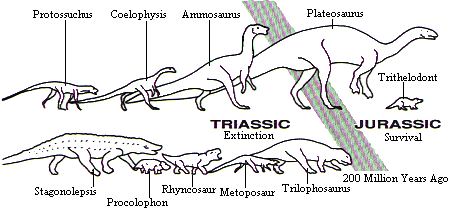The dinosaurs of Nova Scotia are very important because they are rare examples of the animals that survived a major mass extinction event that occurred 200 million years ago.
The first dinosaurs appeared near the end of the Triassic period. During the Jurassic, which began roughly 200 million years ago, many new dinosaur types, from the huge sauropods to tiny bird-like predators, evolved. The Bay of Fundy is the only place where there are abundant bones and footprints from rocks of both ages. This has given paleontologists a rare opportunity to study the changes that occurred at a critical juncture in earth history known as the Triassic-Jurassic boundary.
“This is the only place where you can see accurately dated, the change in the animal assemblage through that critical time when the dinosaurs began to rule the earth.”
Paul Olsen, 1984
 The Prosauropod dinosaurs being studied at the museum are examples of animals that survived the mass extinction. Scientists at the Museum are trying to find out what permitted them to survive such a dramatically changing world.
The Prosauropod dinosaurs being studied at the museum are examples of animals that survived the mass extinction. Scientists at the Museum are trying to find out what permitted them to survive such a dramatically changing world.
Nearly half of the Triassic creatures failed to survive this threshold of time. Some scientists believe that the extinctions or “great dyings” that have been repeated many times throughout geological history are related to catastrophic events, perhaps asteroids hurtling into the earth. The fossil evidence at Parrsboro strongly suggests a “catastrophic extinction” heralded the dawning of the dinosaurs’ reign at the Triassic-Jurassic boundary.
World’s Smallest Footprint
In April 1984, Parrsboro fossil collector Eldon George uncovered some of the world’s smallest dinosaur footprints. The three-toed, half inch long footprints were made by a creature no bigger than a robin. Other trackways along the North Shore of the Minas Basin indicate that most Triassic-Jurassic age dinosaurs were turkey to ostrich size. According to Olsen, this adds to the growing body of evidence that some dinosaurs may have been warm-blooded like birds, without having to be large. However, there are also abundant 18-inch tracks belonging to the Otozoum, thought to be made by a long-legged relative of the crocodiles or by a plant eating Prosauropod. A number of these footprints can be seen at the Parrsboro Rock and Mineral Shop. With predators like this stalking the mudflats, only the fast runners risked venturing onto the exposed lakeshore.
Site Protection
The cause of the great dyings is only one, though perhaps the most significant, question the Parrsboro fossil trove may answer. Each year the famed Fundy tides expose new materials. However, because the fossils are concentrated in relatively small areas and the answers they hold are so important to science, it is vital that all fossils are preserved for study. The Special Places Protection Act protects all fossils found in the province for the benefit of everyone. A brochure describing the Act may be obtained free of charge from the Nova Scotia Museum.
Daniel
why is there never any specimens of fossils found in Nova Scotia to look at other than sites directing us to museums..I’ve found fossil trees, bivalves(at least 3 different species),coral,ferns,and more but hardly any of those things come up on searches. This whole province is a friggin fossil but they make it illegal for us to collect them and save them from certain destruction by the tides. every day. lost forever. Things need to change.
Dino Dan
I love dinos so much, I named by first born Raptor. He is a nightmare.
dylan
dinasoors r soooo kewl
lizard lover
i love dinosaurs and i love the bay of fundy!!!!!!!